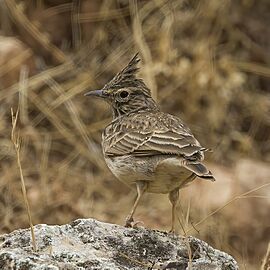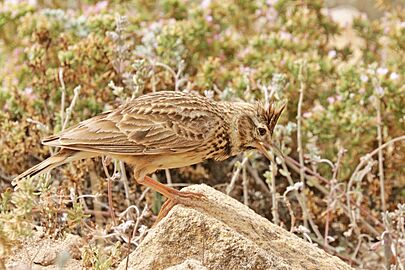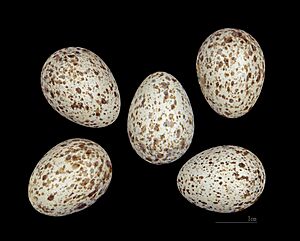Thekla's lark facts for kids
Quick facts for kids Thekla's lark |
|
|---|---|
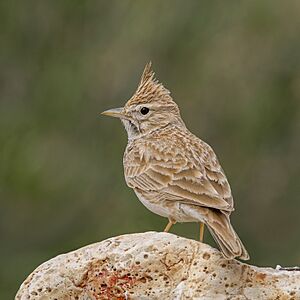 |
|
| G. t. carolinae in the desert South East of Douz, Tunisia |
|
| Conservation status | |
| Scientific classification | |
| Genus: |
Galerida
|
| Species: |
theklae
|
| Subspecies | |
|
See text |
|
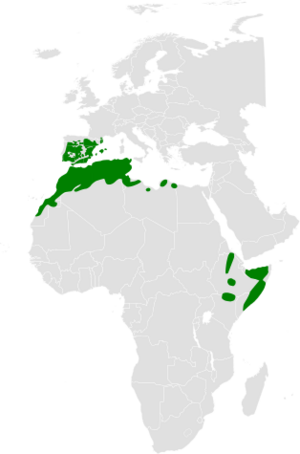 |
|
| Synonyms | |
|
|
The Thekla's lark (Galerida theklae) is a small bird that belongs to the lark family. You can find these birds living in places like Spain and Portugal, as well as across northern Africa and parts of Africa south of the Sahara Desert, from Senegal to Somalia. Unlike some birds that fly long distances for winter, the Thekla's lark stays in the same area all year round.
These larks are often seen in dry, open areas, sometimes even high up in the hills. A scientist named Alfred Edmund Brehm gave the bird its name in 1857, honoring his sister, Thekla. The name "Thekla" comes from an old Greek word meaning "glory of God." Even though the number of these birds is going down in Spain, the Thekla's lark is still quite common across its wide home range. Because of this, experts say it is a "least concern" species, meaning it's not currently in danger of disappearing.
Contents
About Thekla's Lark
Scientists group living things into categories, and this is called taxonomy. The Thekla's lark has several different types, called subspecies, especially in East Africa. These different types are quite unique genetically, which means they might even be considered separate species one day.
Different Types of Thekla's Lark
There are twelve recognized subspecies of Thekla's lark. Each one lives in a slightly different area:
- G. t. theklae - This one is also called the Iberian Thekla's lark. You can find it in Portugal, Spain, the Balearic Islands, and a small part of southern France.
- North Moroccan Thekla's lark (G. t. erlangeri) - Lives in northern Morocco.
- Central Moroccan Thekla's lark (G. t. ruficolor) - Found in central and north-eastern Morocco, northern Algeria, and northern Tunisia.
- G. t. theresae - Lives in south-western Morocco and Mauritania.
- Hauts Plateaux Thekla's lark (G. t. superflua) - Found in eastern Morocco, northern Algeria, and eastern Tunisia.
- North African Thekla's lark (G. t. carolinae) - This type lives from eastern Morocco, across the northern Sahara desert, to north-western Egypt.
- G. t. harrarensis - Found in eastern Ethiopia.
- G. t. huei - Lives in south-central Ethiopia.
- Abyssinian Thekla's lark (G. t. praetermissa) - Found from southern Eritrea to central Ethiopia.
- Somali Thekla's lark (G. t. ellioti) - Lives in northern and central Somalia.
- G. t. mallablensis - Found in southern Somalia.
- G. t. huriensis - Lives in southern Ethiopia and northern Kenya.
-
G. t. theklae
in hills near Loja, Granada, Spain
What Thekla's Lark Looks Like
The Thekla's lark is a small bird, a bit smaller than the well-known Eurasian skylark. It has a long, spiky crest of feathers on its head that it can raise up. Its body is mostly grey with dark streaks on top and whitish underneath.
This lark is greyer than the Eurasian skylark and doesn't have the white edges on its wings and tail that the skylark does. It looks very similar to another common bird called the crested lark. However, the Thekla's lark is usually smaller and a bit greyer, with a shorter beak. When it flies, you can see its grey feathers under its wings, while the crested lark has reddish feathers there. Male and female Thekla's larks look very similar.
Where Thekla's Lark Lives
The Thekla's lark lives all year round in countries like France, Spain, Portugal, Algeria, Egypt, Eritrea, Ethiopia, Kenya, Libya, Morocco, Somalia, Tunisia, and Western Sahara. It prefers to live in rough areas with bushes, bare patches of ground, and dry grasslands.
Life and Habits
The Thekla's lark builds its nest on the ground. The female bird usually lays between two and six eggs. These birds eat mostly seeds from weeds and insects. They especially like to eat insects during the breeding season when they are raising their young.
The song of the Thekla's lark is very pretty and changes a lot. It includes sad-sounding whistles and can even copy the sounds of other birds. Its song is softer and more musical than the crested lark's song. The Thekla's lark can sing while flying, or from the ground, or from a high spot where it can be easily seen.



